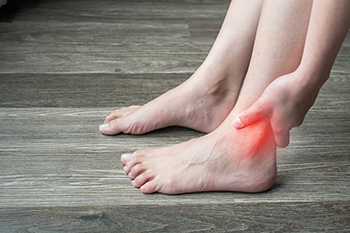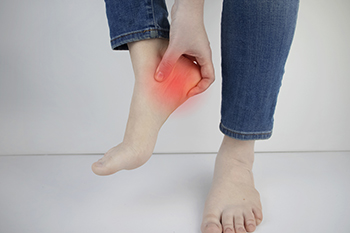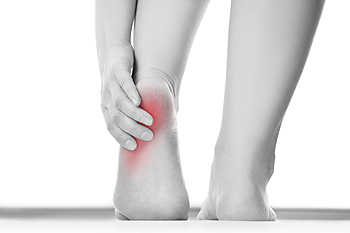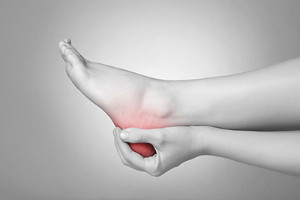
 While most of the time ankle pain generates from an injury, it sometimes occurs without an obvious incident you can pin point it back to. Ankle pain can actually occur due to a variety of underlying causes that you may not have considered, including arthritis. The 3 types of arthritis that primarily affects the ankles are osteoarthritis (where the cartilage between the bones begins to wear away), rheumatoid arthritis (an autoimmune disorder that causes the immune system to attack healthy joints), or reactive arthritis (which is caused by a bacterial infection in another part of the body). Other various conditions, such as gout, fallen arches, a bone or joint infection, bursitis, or even lupus can lead to unexplainable ankle pain. If you have ankle pain, consulting with a podiatrist for a proper diagnosis is highly suggested. Upon diagnosis, a podiatrist will also be able to help suggest treatment options for your specific condition.
While most of the time ankle pain generates from an injury, it sometimes occurs without an obvious incident you can pin point it back to. Ankle pain can actually occur due to a variety of underlying causes that you may not have considered, including arthritis. The 3 types of arthritis that primarily affects the ankles are osteoarthritis (where the cartilage between the bones begins to wear away), rheumatoid arthritis (an autoimmune disorder that causes the immune system to attack healthy joints), or reactive arthritis (which is caused by a bacterial infection in another part of the body). Other various conditions, such as gout, fallen arches, a bone or joint infection, bursitis, or even lupus can lead to unexplainable ankle pain. If you have ankle pain, consulting with a podiatrist for a proper diagnosis is highly suggested. Upon diagnosis, a podiatrist will also be able to help suggest treatment options for your specific condition.
Ankle pain can be caused by a number of problems and may be potentially serious. If you have ankle pain, consult with Dr. Stephan J. LaPointe from Georgia Foot & Ankle Specialists . Our doctor will assess your condition and provide you with quality foot and ankle treatment.
Ankle pain is any condition that causes pain in the ankle. Due to the fact that the ankle consists of tendons, muscles, bones, and ligaments, ankle pain can come from a number of different conditions.
Causes
The most common causes of ankle pain include:
Symptoms
Symptoms of ankle injury vary based upon the condition. Pain may include general pain and discomfort, swelling, aching, redness, bruising, burning or stabbing sensations, and/or loss of sensation.
Diagnosis
Due to the wide variety of potential causes of ankle pain, podiatrists will utilize a number of different methods to properly diagnose ankle pain. This can include asking for personal and family medical histories and of any recent injuries. Further diagnosis may include sensation tests, a physical examination, and potentially x-rays or other imaging tests.
Treatment
Just as the range of causes varies widely, so do treatments. Some more common treatments are rest, ice packs, keeping pressure off the foot, orthotics and braces, medication for inflammation and pain, and surgery.
If you have any questions, please feel free to contact our office located in Rome, GA . We offer the newest diagnostic and treatment technologies for all your foot care needs.
The calf muscles are located at the back of the lower leg and are responsible for the way our feet and ankles move. Tight calf muscles can affect the position of the foot, impacting motion and balance. Regularly stretching the calf muscles helps reduce lower limb pain, tightness, and instability. To get the best results from calf stretches, it is important to hold the stretch for at least 30 seconds. This gives the muscles enough time to stretch out. You should also repeat each calf stretch three times for maximum benefits. Calf stretches can be uncomfortable, but should not be painful. Stop stretching if the mild discomfort associated with stretching turns into pain. Finally, stay safe by consulting with your podiatrist prior to beginning any new stretching or exercise regimen.
Why Stretching Is Important for Your Feet
Stretching the feet is a great way to prevent injuries. If you have any concerns with your feet consult with Dr. Stephan J. LaPointe from Georgia Foot & Ankle Specialists . Our doctor will assess your condition and provide you with quality foot and ankle treatment.
Stretching the Feet
Stretching the muscles in the foot is an important part in any physical activity. Feet that are tight can lead to less flexibility and make you more prone to injury. One of the most common forms of foot pain, plantar fasciitis, can be stretched out to help ease the pain. Stretching can not only ease pain from plantar fasciitis but also prevent it as well. However, it is important to see a podiatrist first to determine if stretching is right for you. Podiatrists can also recommend other ways to stretch your feet. Once you know whether stretching is right for you, here are some excellent stretches you can do.
It is best to go easy when first stretching your foot and work your way up. If your foot starts hurting, stop exercising to ice and rest the foot. It is advised that you then see a podiatrist for help.
If you have any questions, please feel free to contact our office located in Rome, GA . We offer the newest diagnostic and treatment technologies for all your foot care needs.
Thickened toenails are typically a sign of a fungal toenail infection, which can cause changes in the texture and color of the toenail. An infected toenail can often thicken, become brittle or crumbly, and develop white, yellow, or brown discoloration. But while fungal infections are the most common cause of thickened toenails, they are not the only cause. Psoriasis, a skin condition, can also affect the toenails, making them thicker, pitted, and discolored. Paronychia, a nail disease caused by a bacterial infection, can thicken the toenail, make it discolored, and cause redness, pain, and inflammation around the nail. Diabetes can cause toenails to thicken because not enough nutrients are reaching the toenails to maintain their health. Other reasons your toenails may be thickened include onychogryphosis (Ram’s Horn), aging, a toenail injury, or a rare condition called yellow nail syndrome. If you notice changes in the thickness, color, or shape of your toenails, it is suggested that you schedule an appointment with a podiatrist.
If left untreated, toenail fungus may spread to other toenails, skin, or even fingernails. If you suspect you have toenail fungus it is important to seek treatment right away. For more information about treatment, contact Dr. Stephan J. LaPointe of Georgia Foot & Ankle Specialists . Our doctor can provide the care you need to keep you pain-free and on your feet.
Symptoms
Treatment
If self-care strategies and over-the-counter medications does not help your fungus, your podiatrist may give you a prescription drug instead. Even if you find relief from your toenail fungus symptoms, you may experience a repeat infection in the future.
Prevention
In order to prevent getting toenail fungus in the future, you should always make sure to wash your feet with soap and water. After washing, it is important to dry your feet thoroughly especially in between the toes. When trimming your toenails, be sure to trim straight across instead of in a rounded shape. It is crucial not to cover up discolored nails with nail polish because that will prevent your nail from being able to “breathe”.
In some cases, surgical procedure may be needed to remove the toenail fungus. Consult with your podiatrist about the best treatment options for your case of toenail fungus.
If you have any questions, please feel free to contact our office located in Rome, GA . We offer the newest diagnostic and treatment technologies for all your foot care needs.
Charcot Marie Tooth (CMT) disease is a neurological condition characterized by a weakness and loss of sensation in the legs, hands, and feet due to nerve damage. This condition is genetic, affecting approximately 1 in every 2500 people. CMT develops gradually over time and progressively worsens. While there is no cure, a podiatrist can help you manage the symptoms of CMT in your feet. People with this condition may experience a change in the structure of their feet, developing high arches and hammertoes. Pain, muscle weakness, altered sensation, and muscle cramps are also common. Your podiatrist may recommend a treatment program consisting of foot strengthening and stretching exercises, orthotics, pain medication, and possibly surgery to reduce symptoms and maintain your mobility and quality of life. If you suffer from CMT disease, seeing a podiatrist can help.
Neuropathy
Neuropathy can be a potentially serious condition, especially if it is left undiagnosed. If you have any concerns that you may be experiencing nerve loss in your feet, consult with Dr. Stephan J. LaPointe from Georgia Foot & Ankle Specialists . Our doctor will assess your condition and provide you with quality foot and ankle treatment for neuropathy.
What Is Neuropathy?
Neuropathy is a condition that leads to damage to the nerves in the body. Peripheral neuropathy, or neuropathy that affects your peripheral nervous system, usually occurs in the feet. Neuropathy can be triggered by a number of different causes. Such causes include diabetes, infections, cancers, disorders, and toxic substances.
Symptoms of Neuropathy Include:
Those with diabetes are at serious risk due to being unable to feel an ulcer on their feet. Diabetics usually also suffer from poor blood circulation. This can lead to the wound not healing, infections occurring, and the limb may have to be amputated.
Treatment
To treat neuropathy in the foot, podiatrists will first diagnose the cause of the neuropathy. Figuring out the underlying cause of the neuropathy will allow the podiatrist to prescribe the best treatment, whether it be caused by diabetes, toxic substance exposure, infection, etc. If the nerve has not died, then it’s possible that sensation may be able to return to the foot.
Pain medication may be issued for pain. Electrical nerve stimulation can be used to stimulate nerves. If the neuropathy is caused from pressure on the nerves, then surgery may be necessary.
If you have any questions, please feel free to contact our office located in Rome, GA . We offer the newest diagnostic and treatment technologies for all your foot care needs.
 The plantar fascia is a tendon located on the bottom of the foot. It is known for being strong and inflexible, and supports the arch of the foot. This tendon connects the heel to the toes, and a healthy plantar fascia plays a significant role in completing daily activities without pain. An imbalance in the style of walking can alter the foot mechanics, and the plantar fascia may become damaged. This can lead to inflammation of this tendon, which in turn may become plantar fasciitis. Some of the causes that are associated with this ailment can include obesity, and standing on hard surfaces for the majority of the day. Additionally, a sudden increase in speed and intensity during running may lead to gradual development of plantar fasciitis. This condition can cause severe pain and discomfort, and it is suggested that you are under the care of a podiatrist who can properly diagnose and treat plantar fasciitis.
The plantar fascia is a tendon located on the bottom of the foot. It is known for being strong and inflexible, and supports the arch of the foot. This tendon connects the heel to the toes, and a healthy plantar fascia plays a significant role in completing daily activities without pain. An imbalance in the style of walking can alter the foot mechanics, and the plantar fascia may become damaged. This can lead to inflammation of this tendon, which in turn may become plantar fasciitis. Some of the causes that are associated with this ailment can include obesity, and standing on hard surfaces for the majority of the day. Additionally, a sudden increase in speed and intensity during running may lead to gradual development of plantar fasciitis. This condition can cause severe pain and discomfort, and it is suggested that you are under the care of a podiatrist who can properly diagnose and treat plantar fasciitis.
Plantar fasciitis is a common foot condition that is often caused by a strain injury. If you are experiencing heel pain or symptoms of plantar fasciitis, contact Dr. Stephan J. LaPointe from Georgia Foot & Ankle Specialists . Our doctor can provide the care you need to keep you pain-free and on your feet.
What Is Plantar Fasciitis?
Plantar fasciitis is one of the most common causes of heel pain. The plantar fascia is a ligament that connects your heel to the front of your foot. When this ligament becomes inflamed, plantar fasciitis is the result. If you have plantar fasciitis you will have a stabbing pain that usually occurs with your first steps in the morning. As the day progresses and you walk around more, this pain will start to disappear, but it will return after long periods of standing or sitting.
What Causes Plantar Fasciitis?
There are some risk factors that may make you more likely to develop plantar fasciitis compared to others. The condition most commonly affects adults between the ages of 40 and 60. It also tends to affect people who are obese because the extra pounds result in extra stress being placed on the plantar fascia.
Prevention
There are a variety of treatment options available for plantar fasciitis along with the pain that accompanies it. Additionally, physical therapy is a very important component in the treatment process. It is important that you meet with your podiatrist to determine which treatment option is best for you.
If you have any questions, please feel free to contact our office located in Rome, GA . We offer the newest diagnostic and treatment technologies for all your foot care needs.
 Podiatrists frequently diagnose and treat heel pain. Typically, heel pain can be attributed to two main causes. The first is overuse. If you regularly put excess pressure and strain on your heels from prolonged standing, walking long distances, running, playing sports, or wearing ill-fitted shoes, you may be more likely to experience heel pain. The second potential cause is a biomechanical problem, or a problem with the structure or function of your feet. The most common biomechanical issue is an overpronated gait, a walking pattern in which the feet turn too far inwards with each step. This is frequently seen in patients with flat feet and can contribute to plantar fasciitis and other conditions that cause heel pain. Sometimes, a combination of both overuse and an underlying biomechanical problem are to blame for heel pain. If you are experiencing heel pain, don’t hesitate to schedule an appointment with a podiatrist near you.
Podiatrists frequently diagnose and treat heel pain. Typically, heel pain can be attributed to two main causes. The first is overuse. If you regularly put excess pressure and strain on your heels from prolonged standing, walking long distances, running, playing sports, or wearing ill-fitted shoes, you may be more likely to experience heel pain. The second potential cause is a biomechanical problem, or a problem with the structure or function of your feet. The most common biomechanical issue is an overpronated gait, a walking pattern in which the feet turn too far inwards with each step. This is frequently seen in patients with flat feet and can contribute to plantar fasciitis and other conditions that cause heel pain. Sometimes, a combination of both overuse and an underlying biomechanical problem are to blame for heel pain. If you are experiencing heel pain, don’t hesitate to schedule an appointment with a podiatrist near you.
Many people suffer from bouts of heel pain. For more information, contact Dr. Stephan J. LaPointe of Georgia Foot & Ankle Specialists . Our doctor can provide the care you need to keep you pain-free and on your feet.
Causes of Heel Pain
Heel pain is often associated with plantar fasciitis. The plantar fascia is a band of tissues that extends along the bottom of the foot. A rip or tear in this ligament can cause inflammation of the tissue.
Achilles tendonitis is another cause of heel pain. Inflammation of the Achilles tendon will cause pain from fractures and muscle tearing. Lack of flexibility is also another symptom.
Heel spurs are another cause of pain. When the tissues of the plantar fascia undergo a great deal of stress, it can lead to ligament separation from the heel bone, causing heel spurs.
Why Might Heel Pain Occur?
Treatments
Heel pain should be treated as soon as possible for immediate results. Keeping your feet in a stress-free environment will help. If you suffer from Achilles tendonitis or plantar fasciitis, applying ice will reduce the swelling. Stretching before an exercise like running will help the muscles. Using all these tips will help make heel pain a condition of the past.
If you have any questions please contact our office located in Rome, GA . We offer the newest diagnostic and treatment technologies for all your foot and ankle needs.
The ankle is a complex joint composed of bones and ligaments. It is critical for movement and balance. Because the ankle works so hard during walking, running, and jumping, it can become sprained, or fractured—especially during sports and other physical activities. Sprains occur when the ligaments that connect ankle bones and provide stability become injured. This can happen when the ligaments are overly stretched, partially torn, or completely torn. Ankle sprains can cause inflammation, bruising, swelling, and pain of varying degrees. Fractures are actual breaks in one or more of the ankle bones and are usually due to acute trauma. Stress fractures are tiny cracks in the bone that develop over time. Both types of fractures cause pain and swelling, although stress fractures may produce more gradual pain and less swelling than a regular break in the bone. A podiatrist can assess and diagnose any pain in the ankle and treat it accordingly.
Ankle pain can have many different causes and the pain may potentially be serious. If you have ankle pain, consult with Dr. Stephan J. LaPointe from Georgia Foot & Ankle Specialists . Our doctor will assess your condition and provide you with quality foot and ankle treatment.
Ankle pain is any condition that causes pain in the ankle. Due to the fact that the ankle consists of tendons, muscles, bones, and ligaments, ankle pain can come from a number of different conditions.
Causes
The most common causes of ankle pain include:
Symptoms
Symptoms of ankle injury vary based upon the condition. Pain may include general pain and discomfort, swelling, aching, redness, bruising, burning or stabbing sensations, and/or loss of sensation.
Diagnosis
Due to the wide variety of potential causes of ankle pain, podiatrists will utilize a number of different methods to properly diagnose ankle pain. This can include asking for personal and family medical histories and of any recent injuries. Further diagnosis may include sensation tests, a physical examination, and potentially x-rays or other imaging tests.
Treatment
Just as the range of causes varies widely, so do treatments. Some more common treatments are rest, ice packs, keeping pressure off the foot, orthotics and braces, medication for inflammation and pain, and surgery.
If you have any questions, please feel free to contact our office located in Rome, GA . We offer the newest diagnostic and treatment technologies for all your foot care needs.
 Sever’s disease is an injury that causes pain in the back of the heel in patients between the ages of 8 and 15. this condition may be a result of a growth spurt when the muscles and tendons in the calves can not keep up with the growth rate of the bones. The tight muscles put more stress on the Achilles tendon particularly where it attaches to the heel bone. Sever’s disease is most common in active adolescents who do a lot of sports training or physical activity. The most common sign is pain in the back of the heel, but other signs of Sever’s disease include worsening pain with physical activity and pain that gets worse throughout the day. If your child is complaining about pain in their heels, consulting with a podiatrist for a proper diagnosis and treatment is suggested.
Sever’s disease is an injury that causes pain in the back of the heel in patients between the ages of 8 and 15. this condition may be a result of a growth spurt when the muscles and tendons in the calves can not keep up with the growth rate of the bones. The tight muscles put more stress on the Achilles tendon particularly where it attaches to the heel bone. Sever’s disease is most common in active adolescents who do a lot of sports training or physical activity. The most common sign is pain in the back of the heel, but other signs of Sever’s disease include worsening pain with physical activity and pain that gets worse throughout the day. If your child is complaining about pain in their heels, consulting with a podiatrist for a proper diagnosis and treatment is suggested.
Sever's disease often occurs in children and teens. If your child is experiencing foot or ankle pain, see Dr. Stephan J. LaPointe from Georgia Foot & Ankle Specialists . Our doctor can treat your child’s foot and ankle needs.
Sever’s Disease
Sever’s disease is also known as calcaneal apophysitis, which is a medical condition that causes heel pain I none or both feet. The disease is known to affect children between the ages of 8 and 14.
Sever’s disease occurs when part of the child’s heel known as the growth plate (calcaneal epiphysis) is attached to the Achilles tendon. This area can suffer injury when the muscles and tendons of the growing foot do not keep pace with bone growth. Therefore, the constant pain which one experiences at the back of the heel will make the child unable to put any weight on the heel. The child is then forced to walk on their toes.
Symptoms
Acute pain – Pain associated with Sever’s disease is usually felt in the heel when the child engages in physical activity such as walking, jumping and or running.
Highly active – Children who are very active are among the most susceptible in experiencing Sever’s disease, because of the stress and tension placed on their feet.
If you have any questions, please feel free to contact our office located in Rome, GA . We offer the newest diagnostic and treatment technologies for all your foot and ankle injuries.